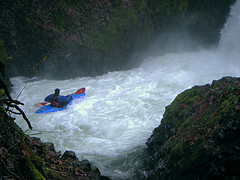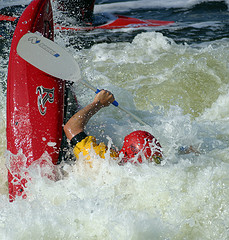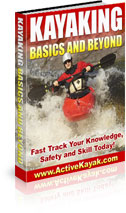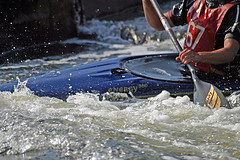|
WHITE WATER KAYAK
Basics of the White Water Kayak Whitewater kayaking can be a lot of fun and it really is not that difficult of a sport to get the hang of. Unless you are traveling on a river that is known for a number of hazards, the Strokes The basics of stroking on a kayak should be practiced on areas with no whitewater. This will develop the simple skills needed to handle more difficult waters. journey can be rather smooth. I did a lot of practice on a lake prior to hitting the white water kayak. Forward and reverse paddling allow the kayak to move in a straight line (hopefully) while forward and reverse sweep strokes are designed to turn the kayak. The draw stroke and the sculling draw are intended to get you to the side of the river without turning. Brace strokes are vital to learn because they keep you form capsizing. Basics In order to learn the basics of these strokes, it is highly recommended to take lessons from a knowledgeable instructor. I finally did this and it helped so much. This way, you will get a good introduction to the basics which will help you achieve the skill needed to be a talented and successful kayaker. You will also learn a lot of helpful tips from the instructor such as how to be wary of ripple since they represent potential obstructions in the water among other things. This can save you a tumble in the water or two!
Common terms to be familiar with include: Eddy Lines: An eddy is the region of the river where the current slows down and becomes more manageable. When you are struggling with the current, you may wish to make an ‘eddy turn' which would take you in the direction of an eddy line which would deliver a much easier area in which to rest your kayak and get it under control. Wave Trains: Wave trains can refer to the extremely difficult conditions brought forth by powerful waves that develop in the waters. Developing skill with riding wave trains can reduce the potential for a serious problem arising that can hinder the safety of the venture. For some, the ability to ride a wave train adds a sense of excitement to the process. But, this is certainly not something that can be done easily and is best left to the more experienced kayaker. 
Holes: These can be very problematic spots in the river as they indicate an area where water crashes over a submerged object making a hazard for the kayaker. In some instances, experienced kayakers will take advantage of the presence of a hole to make their trek a little more exciting. Those that are novices in the world of kayaking would be best served steering cleat of holes since they can cause all manner of operational problems. Pillow: The technical term for a pillow is a pressure wave and it refers to a clash between a significant flow of water and some sort of heavy obstruction in the water. When the two clash the end result is a piling up of white water at the front of the obstructing object. This creates the very hazardous scenario of a pile up that might swell under the white water kayak. 
As a result, the kayak runs the potential of being overturned which is certainly not a positive scenario to find oneself. So, if a pillow appears in the water, it is best to do what is necessary to avoid it. If not, a dangerous turnover might occur. Strainers: These are objects in the water that do not block the flow of water but would certain pose a risk to anything trying to pass through the water. A tree that has fallen into the river would be an example of this. And, of course, it is suggested to avoid such obstructions since they might pose a serious threat to anyone traveling on the water. Accidentally I ran into a down tree. The boat pinned me for several seconds and I was drowning. I felt like I was too let go (which is not recommended) and go under the tree. I did and popped out the other side. It was very scary, so watch out for those strainers! Does this seem like there is a lot to know about kayaking? Well, this may be true but it is also a good thing. The reason is, of course, you want to make your whitewater adventures as safe and fun as possible. understanding hazards is key to such safety. To get a jump start on your instructions I recommend reading
Kayking: Basics and Beyond.
Return to Adventure Racing from White Water Kayak
|



 Understanding some of the basic terms associated with white water kayaking will increase the odds that your experiences with the white water kayak.
Understanding some of the basic terms associated with white water kayaking will increase the odds that your experiences with the white water kayak.